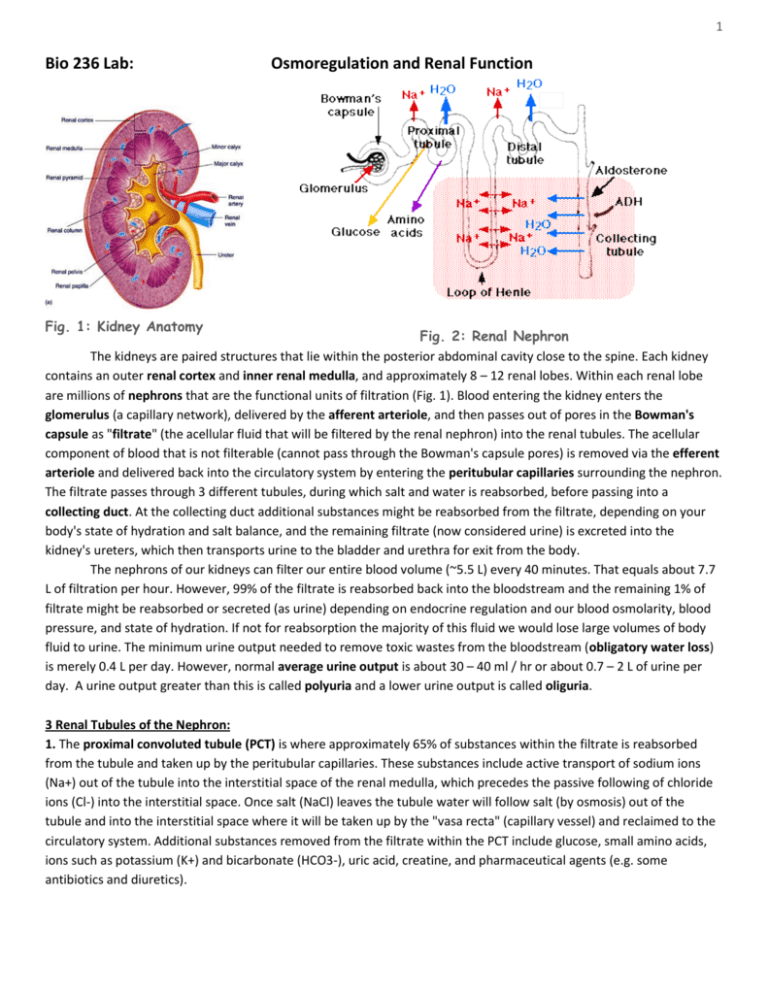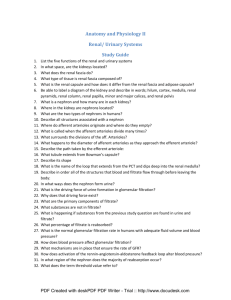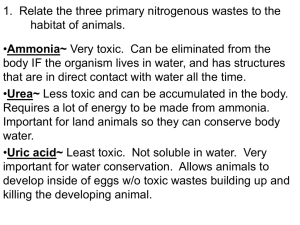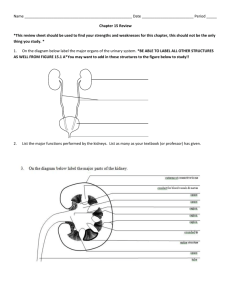Bio 236 Lab: Osmoregulation and Renal Function
advertisement

1 Bio 236 Lab: Osmoregulation and Renal Function Fig. 1: Kidney Anatomy Fig. 2: Renal Nephron The kidneys are paired structures that lie within the posterior abdominal cavity close to the spine. Each kidney contains an outer renal cortex and inner renal medulla, and approximately 8 – 12 renal lobes. Within each renal lobe are millions of nephrons that are the functional units of filtration (Fig. 1). Blood entering the kidney enters the glomerulus (a capillary network), delivered by the afferent arteriole, and then passes out of pores in the Bowman's capsule as "filtrate" (the acellular fluid that will be filtered by the renal nephron) into the renal tubules. The acellular component of blood that is not filterable (cannot pass through the Bowman's capsule pores) is removed via the efferent arteriole and delivered back into the circulatory system by entering the peritubular capillaries surrounding the nephron. The filtrate passes through 3 different tubules, during which salt and water is reabsorbed, before passing into a collecting duct. At the collecting duct additional substances might be reabsorbed from the filtrate, depending on your body's state of hydration and salt balance, and the remaining filtrate (now considered urine) is excreted into the kidney's ureters, which then transports urine to the bladder and urethra for exit from the body. The nephrons of our kidneys can filter our entire blood volume (~5.5 L) every 40 minutes. That equals about 7.7 L of filtration per hour. However, 99% of the filtrate is reabsorbed back into the bloodstream and the remaining 1% of filtrate might be reabsorbed or secreted (as urine) depending on endocrine regulation and our blood osmolarity, blood pressure, and state of hydration. If not for reabsorption the majority of this fluid we would lose large volumes of body fluid to urine. The minimum urine output needed to remove toxic wastes from the bloodstream (obligatory water loss) is merely 0.4 L per day. However, normal average urine output is about 30 – 40 ml / hr or about 0.7 – 2 L of urine per day. A urine output greater than this is called polyuria and a lower urine output is called oliguria. 3 Renal Tubules of the Nephron: 1. The proximal convoluted tubule (PCT) is where approximately 65% of substances within the filtrate is reabsorbed from the tubule and taken up by the peritubular capillaries. These substances include active transport of sodium ions (Na+) out of the tubule into the interstitial space of the renal medulla, which precedes the passive following of chloride ions (Cl-) into the interstitial space. Once salt (NaCl) leaves the tubule water will follow salt (by osmosis) out of the tubule and into the interstitial space where it will be taken up by the "vasa recta" (capillary vessel) and reclaimed to the circulatory system. Additional substances removed from the filtrate within the PCT include glucose, small amino acids, ions such as potassium (K+) and bicarbonate (HCO3-), uric acid, creatine, and pharmaceutical agents (e.g. some antibiotics and diuretics). 2 2. The Loop of Henle. In the loop of Henle there are 2 subdivisions: the descending loop (which leaves the proximal convoluted tubule and descends into the medullary space) and the ascending loop, which rises up from the medulla to meet with the distal convoluted tubule. The descending loop of Henle is permeable to allow water to leave the tubule (by osmosis) and enter the interstitial space but it is NOT permeable to salt. Thus salt stays within the descending loop and passes into the ascending loop. [By the time filtrate has completed its journey through the descending loop approximately 85% of the filtrate fluid volume has left the tubules and been taken up by the vasa recta blood vessel for reincorporation into the body's circulatory system. This 85% volume is always reabsorbed from the filtrate, regardless of your state of hydration or blood osmolarity. The last 15 percent of the total fluid volume of the filtrate is reabsorbed or retained through the collecting duct based on interactions of the duct with endocrine hormones.] The ascending loop of Henle is impermeable to water (will not allow water to leave the tubule) but IS permeable to salt. Thus, Na+ can leave the ascending tubule (through active transport), and Cl- then follows Na+ into the interstitial space. Thus, water remains within the ascending tubule while salt is removed from the tubule. As a result of salt exiting the ascending tubule the interstitial space in the medulla becomes salty (hypertonic) relative to the more dilute contents of the tubule. This gradient will become important for the next step of filtration occurring in the collecting duct. 3. The distal convoluted tubule (DCT) receives the approximately 15% volume remaining of the initial filtrate and it is permeable to salt. Whether filtrate is reabsorbed or retained within the tubule for excretion depends on your body's state of hydration or salt balance and is regulated by the endocrine system. Reabsorption of salt (Na+ and Cl-) in the DCT is regulated by the renal renin-angiotensin-aldosterone system and your body's state of hydration and blood osmolarity. If your blood volume and blood pressure is too low the cells of the macula densa sense this and signal the juxtaglomerular apparatus (cells near the afferent arteriole of the nephron) to secrete renin. Renin stimulates the liver to convert angiotensinogen into angiotensin 1. Angiotensin 1 is converted (by ACE enzymes in the lungs) into angiotensin 2. Angiotensin 2 stimulates the adrenal cortex to secrete aldosterone. Aldosterone is a mineralcorticoid hormone that stimulates arteriole vasoconstriction and to increase salt (Na+ and Cl-) reabsorption within the DCT. Where salt goes water follows by osmosis. Thus, more water is also reabsorbed into the bloodstream. The net result is that your urine output decreases (you pee a smaller volume of more concentrated urine) and your blood volume, blood pressure, and osmolarity increases. If your blood volume and blood pressure is too high renin secretion is inhibited, leading to less angiotensin 2 and aldosterone production. The net result is that less salt and water is reabsorbed by the DCT, urine output increases (you pee a higher volume of more dilute urine), and your blood volume, pressure, and osmolarity decreases. The collecting duct: The collecting duct can allow some water reabsorption in response to endocrine regulation by antidiuretic hormone (ADH). The first part of the collecting duct is sensitive to stimulation by ADH but the lower regions are not. Your hypothalamus has a "set point" for blood osmolarity at 280-290 mOsm. If your blood osmolarity is above this set point the hypothalamic nuclei (paraventricular nucleus and supraoptic nucleus) will produce ADH (antidiuretic hormone) and release it from the posterior pituitary. ADH will increase the permeability of the collecting duct to water, allowing water to leave the duct and be reclaimed by the bloodstream. The net effect is that more water is returned to your bloodstream, urine output is decreased (you pee a smaller volume of more concentrated urine), your blood volume and blood pressure will rise, and your blood osmolarity will decrease. If your blood osmolarity is lower than the hypothalamic set point the hypothalamus will decrease secretion of ADH, causing decreased water permeability of the collecting duct. The net result is less water is reclaimed by the bloodstream, urine output is increased (you pee a larger volume of more dilute urine), your blood volume and blood pressure decreases, and your blood osmolarity increases. The collecting duct receives the remaining "waste" filtrate and delivers it to the minor calyx, then major calyx of the kidney. Urine then exits the kidney through the ureter. 3 Osmoregulation Experiment: In this lab we will investigate the osmoregulatory effects of ingestion of different fluids. After ingestion we will collect urine at 0 minutes, 30 minutes, 60 minutes, 90 minutes and 120 minutes. Data collected will be: 1. volume and calculate rate 3. pH 2. specific gravity 4. Chloride ion concentration and calculate mass The solutions we will ingest will vary in pH and osmolarity. Divide evenly into groups, ensuring that more than one student drinks each solution. Solutions: 1. 500 ml of tap water. 2. 500 ml of isotonic saline (0.9% NaCl) or equivalent. 3. 75 ml of 5% saline. 4. 250 ml of 0.2% sodium bicarbonate (NaHCO3), an alkaline solution. Note: if ingesting the solutions makes you feel sick STOP DRINKING. If you cannot void a sample, try to wait until the next 30 minute data collection period. If you have to urinate between data collection times, save the sample and add it to the next collection. Record all data in the space provided and add it to the class data sheet. Procedure: 1. Immediately after consuming the prescribed solution take a urine collection container to the bathroom and collect a full specimen of urine. It is the aim to completely empty your bladder. Make sure you record the time of this event as you will take the next samples at 30 minute intervals. 2. Take the sample back to the laboratory for analysis. 3. First measurement to take is volume of urine and record it on the data sheet. On the 2nd and later samples you will be able to calculate the rate of urine produced in the last 30 minutes (vol/30 = urine production per minute). 4. Use the indicator paper to measure the pH and record this on the data sheet. 5. Measure and record the specific gravity of your sample (see below). 6. Perform a titration and determine the Cl- concentration (see below). 7. Repeat steps 1-6 at intervals of 30, 60, 90 and 120 minutes. Specific gravity Specific gravity is a measure of the solute concentration of a solution. It is measured by using the urinometer. Fill the cylinder with urine and insert the float. It has an imbedded scale, which is read at the surface of the urine. The greater the specific gravity i.e. the higher the solute concentration the higher in the water the float will sit. Pure water has a specific gravity of 1.000. Your urine sample will have a specific gravity between 1.000 and about 1.030. Cl- concentration - A simple titration will determine the Cl- concentration. a. measure 10 drops of urine into a test tube ( each drop is approx 0.5 ml). b. with a clean pipette, add 1 drop of 20% potassium chromate, K2CrO4. c. with a third pipette add 2.9% silver nitrate, AgNO3, one drop at a time. Agitate the test tube after each drop. Continue adding the silver nitrate until the solution changes color from bright yellow to a mustard brown. The color change should be quite sudden. Each drop of 2.9% silver nitrate added to achieve the color change represents 61 mg of Cl- per 100 ml of urine. e.g. 10 drops x 61 mg of Cl- mg/100ml = 610 mg Cl-/100ml 4 Volume (mL) Solution Tap water 1 Tap water 2 Iso Saline 1 Iso Saline 2 5% Saline 1 5% Saline 2 Sodium Bicarb 1 Sodium Bicarb 2 0 30 60 90 Rate (mL/min) 120 030 3060 6090 90120 Specific Gravity 0 30 60 90 pH 120 0 30 60 Chloride (mg/100 ml) 90 120 0 30 60 90 120 5 Osmoregulation Questions: Name ______________________________ 1. What proportion of the ingested liquid was excreted during the 2 hour period for each of the solutions? 2. How much Cl- (in mg) was excreted in the 2 hour period for each of the four solutions? 3. Did the alkaline solution cause a change in urine pH? If so, why? 4. Compare the data from the four different conditions. Describe differences observed and determine the cause for the differences. Use additional pages if necessary. 6 5. Which tubule within the nephron allows for absorption of glucose, small amino acids, uric acid, and creatine, along with Na+, Cl-, K+, and water? ________________________________ 6. Which part of Henle’s loop is permeable to: A) water but not salt (NaCl)? _____________________ B) salt but not water? ________________________ 7. How is aldosterone produced? ____________________________________________________________________ ________________________________________________________________________________________________ ________________________________________________________________________________________________ 8. What is the effect of aldosterone on the distal convoluted tubule? _______________________________________ ________________________________________________________________________________________________ 9. What is the effect of Antidiuretic hormone (ADH)? _____________________________________________________ ________________________________________________________________________________________________ 10. What sequence of events would occur if your hypothalamus senses that your blood osmolarity rises above 290 mOsm? ____________________________________________________________________________________ ___________________________________________________________________________________________ ___________________________________________________________________________________________ ___________________________________________________________________________________________ ___________________________________________________________________________________________ 11. Blood for filtration enters the Bowman’s capsule through which blood vessel? ______________________ 12. What has been your favorite lab from this semester? ________________________________________ Why? ___________________________________________________________________________ 13. What has been your least favorite lab from this semester? ___________________________________ Why?____________________________________________________________________________







